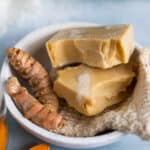Turmeric Soap
This cold process turmeric soap is loaded with nourishing fats and infused with turmeric, raw honey, and witch hazel to cleanse your skin from head to toe.
Yield: 8 bars
Cost: $15
Equipment
- Cooking thermometer
- Kitchen scale
- Immersion blender
- Rubber spatula
- Measuring spoons
- Measuring cup
- Large heatproof jar or glass jug
- Slow cooker or a non-reactive metal pot
- Soap mold
- White vinegar for spills and cleaning up
- Protective gear goggles, gloves, long sleeves, apron, close-toed shoes
Materials
- 4.4 oz sodium hydroxide (lye)
- 8.4 oz distilled water
- 2 teaspoons turmeric
- 8 oz coconut oil
- 4.8 oz shea butter
- 1.6 oz cocoa butter
- 12.8 oz olive oil
- 4.8 oz sunflower oil
- 0.5 oz raw honey
- 1 oz witch hazel
- 2 teaspoons sodium lactate (optional, helps soap release from the mold faster)
- 99% isopropyl alcohol (optional, to prevent soda ash)
Instructions
- Don your protective gear, including gloves, goggles, and long sleeves, and go outside or into a well-ventilted space. Pour the water into a large jar. Then slowly and carefully add the lye.
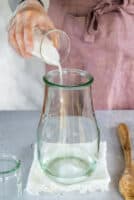
- Stir until the lye has fully dissolved, and the liquid is mostly clear.
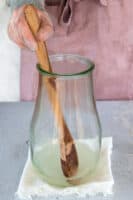
- Add the turmeric and stir again. Set the jar aside to cool for approximately 20–30 minutes.

- Meanwhile, combine all the oils in the base of a crockpot and heat on high, stirring occasionally until just melted (about 20–30 minutes).
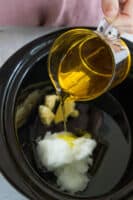
- While you wait for the oils to melt, whisk the honey and witch hazel together in a small bowl and set aside.
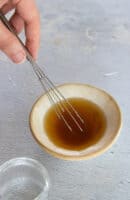
- Using your cooking thermometer, check the temperature of the oils and the lye water. You want them to be between 110 and 120°F and within 10 degrees of each other, ideally. When the lye water reaches the correct temperature, add 2 teaspoons of sodium lactate to the lye water and stir.
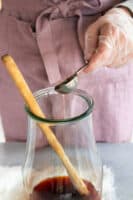
- Then pour the lye water into the slow cooker basin with the melted oils.
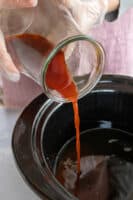
- Using your stick blender, blend the mixture until you reach a thin to medium trace (the consistency of loose pudding). Due to the large amount of liquid oils in this recipe, it may take several minutes to reach trace. Add the honey and witch hazel mixture, and continue blending for anouther 30 seconds, or until the mixture reaches a medium trace.
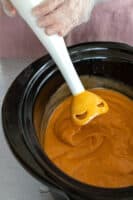
- Pour the batter into the mold and tap on the counter to help get rid of bubbles. Then cover the mold with plastic wrap and set it somewhere it won’t be disturbed. Honey tends to make soap heat up more than normal, so you do not need to insulate the soap—see the notes for more about this.
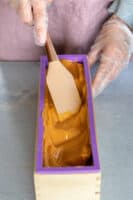
- Allow the soap to stay in the mold for 2–3 days. Because this is a softer recipe, it may need more time in the mold than normal. Remove from the mold and slice into bars. Allow the bars to cure for 4–6 weeks and enjoy!

Notes
Some soap recipes that contain honey say to refrigerate the soap for the first 12–24 hours after pouring it into the mold. The reasoning is that honey causes soap to heat up more than expected, and may “overcook” the soap if it’s left to sit out at room temperature. I put my soap in the refrigerator at first but then took it out once I noticed lots of cracking along the top of the soap. You may want to try placing your soap in the refrigerator for several hours or overnight to prevent overheating. If you notice cracking, take it out of the refrigerator.
You don’t need to use a jar as large as mine when mixing your lye and water. I prefer a large, tapered jar because I feel that it cuts down on the splashing and helps funnel the fumes upward, rather than outward. If you don’t have a large jar, a large measuring cup should work. Just be careful!
After using your bar, put it some place it can dry out thoroughly between uses. Never let it sit in a pool of water.
